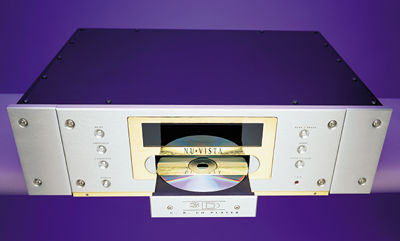| Columns Retired Columns & Blogs |
Musical Fidelity Nu-Vista 3D CD player
What's next for you? Your last CD player? Your first SACD player? DVD-Audio? Looking forward to multichannel music? Still satisfied with two-channel stereo? Maybe you're waiting for an affordable combination SACD/DVD-A multichannel player, or for the format feud to shake out and leave a clear winner. So many options, so much excitement, so little software.

Though their fourth and final limited-edition Nu-Vista product was originally slated to be an SACD player, Musical Fidelity's Antony Michaelson ultimately chose to make it CD only. Better to concentrate efforts on trying to optimize the sound of the 2 billion CDs already in play, he figured, than divert company resources into developing technology and products aimed at an uncertain digital future and an unsettled customer base.
The conventional thinking is that the market for expensive CD players is finished—no one is going to invest heavily in what could quickly become an expensive relic. But Michaelson is convinced that CD will not be going away anytime soon, and that 500 customers will gladly pay $4995 now for the most expensive no-compromise CD player his company has ever built.
Electronics in Musical Fidelity's Nu-Vista line feature the tiny nuvistor triode 6CW4 tube, designed by RCA for the military at the dawn of the solid-state era. Smaller than the tip of your finger, the robust, cool-running device encloses the vacuum in metal instead of glass and offers low noise, heat, and microphony, linear performance, and long life—necessary attributes, if the old technology was to compete successfully with transistors. But with good-sounding weaponry never a high military priority, solid-state supremacy was inevitable; nuvistors became a long-forgotten surplus commodity.
A few years back, Michaelson just about cornered the market on nuvistors—and, almost more important, on nuvistor sockets, which were in shorter supply. Five hundred Nu-Vista preamps were built and quickly sold, as was the 500-unit run of Nu-Vista 300 power amplifiers, one of which is my reference (I reviewed it in December 1999). I'm a very satisfied Musical Fidelity customer.
In February 2001 I reviewed MF's powerful Nu-Vista M3 integrated—essentially the Nu-Vista preamplifier and 300 power amp in a single chassis. (A few of the 500-unit run are still in the pipeline, says Michaelson.) The M3 struck me as sounding exceptionally clean and pure, and an outstanding value for the money. However, I did note an emphasis on transparency over solidity—a quality also noted when I auditioned the Nu-Vista preamp, which I found too cloying to enjoy long-term, though it certainly has a loyal following: auction prices for used ones are well above the original list price.
If you're worried about replacement nuvistors, Musical Fidelity has put aside a spare set for every Nu-Vista product sold. Typical tube life expectancy is about 100,000 hours, and the failure rate, with almost 1500 Nu-Vista products now in the field, is "about 0.1%." So don't worry.
Reiterating the Rationale
The format wars have broken out nowhere more fiercely than in the "Letters" section of Stereophile, where the name-calling between SACD enthusiasts and CD standpatters rages. It's amusing to hear CD enthusiasts being called "Luddites." Regardless of your feelings about the new technology, the fact is that so far only a few hundred SACD titles have been released, most of them sourced from old analog tapes or produced by audiophile labels and recorded directly to DSD (the SACD recording format) with no post-recording mixing, EQ, or other mastering changes involved.
Why? As in the early days of CD, there haven't been DSD mixing boards or other peripheral devices available, so unless you convert to a multi-bit format for editing and mixing—or even to analog—then back to DSD, there can be no editing or mixing. Because the entire purpose of 1-bit, 2.83MHz-sampled SACD is to avoid the lower sampling rates of multibit digital, what would be the point? Still, a few SACDs are so sourced—sort of like those early "pure DDD" CDs that were actually DAD.
This means that it could be years before new, major-label SACD titles hit the market in meaningful quantities. When Musical Fidelity calculated the cost of adding SACD capability to its final Nu-Vista product, it seemed commercially prohibitive, given the 3D's already high price. That's why the final Nu-Vista 3D is a CD player—though it omits HDCD decoding, which leaves yet another digital market niche unfilled.
MF didn't restrain itself in its claims about the 3D's sonic prowess. The introductory press release declares that the player "makes ordinary CDs sound as good as SACD and a lot better than DVD-A." Michaelson told me the statement was not hyperbole—he really believes it. But why listen to a manufacturer when you can listen to his product?
Appearance and Build
It won't take you long to decide if you love or hate the Nu-Vista 3D's looks. As with other Nu-Vista products, the 3D's faceplate is thick, brushed "ultra-pure HE39" aluminum billet accented with 24K gold. As I wrote in my review of the M3, "you'll have to decide whether the M3 Nu-Vista's looks remind you of Cartier, or of a dumpy guy with a comb-over wearing a Star Sapphire pinky ring. And if that's you, I apologize." However, because the 3D lacks the M3's intricate, jewel-like knobbery, it looks cleaner. (When I pressed him, Michaelson admitted that the knob's look was inspired by the bolt-studded, polished-chrome gas-tank filler ring of Audi's sporty TT.)
- Log in or register to post comments



































